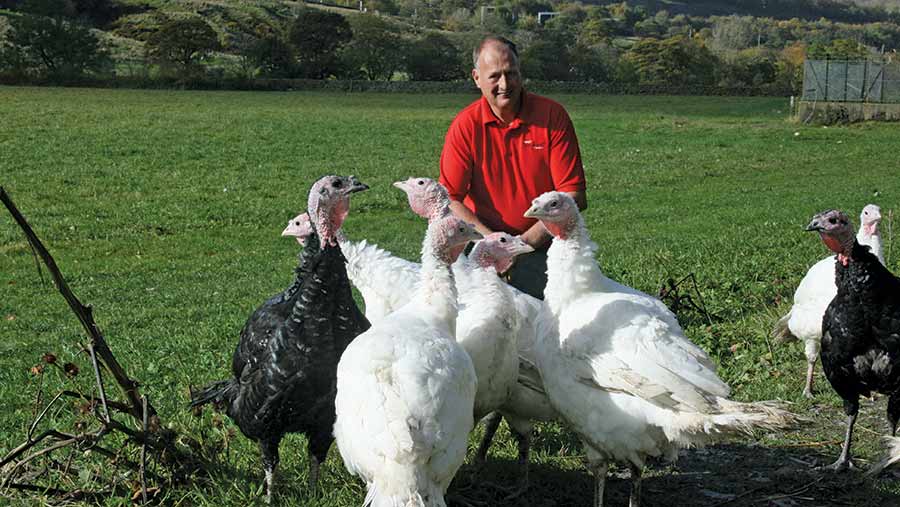Poultry producer wins repeat custom with ‘traditional taste’

Free-range chickens taken to dressed weights of up to almost 4kg and retailing at more than £5/kg are winning significant repeat custom for Cumbrian producer David Knipe.
“It’s not just a case of consumers telling us time and time again that our chickens taste like chicken used to,” says Mr Knipe.
“They soon realise that these good-sized, free-range birds are big enough to provide a family meal and that means they are an alternative to a roast joint.”
High Carlingill Farm sits at 800ft at the foot of the Howgill Fells near Tebay, Cumbria, and has been producing free-range chicken – as well as turkeys and ducks – for six years.
The birds are all slaughtered and dressed on the farm in modern processing facilities.
They are then sold through farmers’ markets – about 12 are attended each month.
Well experienced in producing poultry for the Christmas trade, the Knipe family’s move to High Carlingill Farm prompted the setting up of a year-round free-range system, alongside the farm’s sheep and suckler cows.
“Rearing something and then actually meeting the people who are going to buy it from you and eat it adds a whole new dimension to being a farmer.
See also: Slow growing chicken developed for meat market
“I admit I’m passionate about the quality of the birds I produce – and when you get out there, you realise how many consumers really want to know more about the origins of their food.
“We’re producing chicken with a quality and taste that many consumers have never experienced. Once they’ve tried this chicken they are hooked,” Mr Knipe enthuses.
He acknowledges the expertise that underpins the production of intensive broilers to produce a lower-cost source of white meat.
But most birds that leave Carlingill Farm are well over 2kg, and take 12-16 weeks to get there.
All trussed up
Twin-needle trussing is a mark of the birds produced by Mr Knipe.
“It’s a way of taking the needle through the drumsticks and back through the wings and tying-off at the drumsticks.
“Then we go through the breast bone at the back so that we create a very compact bird and we believe it improves the overall flavour.
“It creates evenness in the cooking and keeps the moisture inside the flesh.”
New arrivals
Up to 400 off-heat Cobb and Ross broiler birds – as well as some French Sasso – arrive on the farm every month aged about four weeks.
The farm’s 2ha poultry field is set-up with rearing arks, based on static caravans that have been specially converted, each providing housing for about 400 birds.
The houses have no base and can be easily lifted using a teleporter and moved to a fresh location in-between batches.
Birds are bedded on deep straw and all houses are thoroughly disinfected between batches.
Mortality is just 1%, despite the fact there is no fox-proof fencing.
About one-third of all the chickens produced are sold as whole birds with the remainder retailed as portions.
“Reducing the amount of chickenmeat we waste when portioning a bird is very important.
“We are achieving some breasts weighing 0.75kg-1.00kg each, so there’s a lot of meat on these birds and it has a very different texture compared with intensively reared chicken.
“We can get some Cobb/Ross birds weighing up to 4kg, but even at that weight we’re finding they are still mobile and active.
“We’re feeding a rearing pellet at 18-19% protein compared with an intensive ration that would contain much more protein, so it’s giving us a slower growth rate.
“We use a vegetable-based diet that doesn’t include fishmeal, but we do add some wheat in the later stages when the Cobb/Ross birds are reaching the top end of the weight range we want.”
French connection
The system has also started to finish some Sasso birds as an alternative.
“They are a slower growing bird and the breast meat has a longer-grain compared with the short-grained meat of the Cobb/Ross.
“There is a distinct difference in the eating quality of the two – and it’s something our customers have noticed and appreciate.
“The meat of the Cobb/Ross birds certainly melts in the mouth, but the meat on the Sasso needs eating more slowly and it’s then that the real flavour comes through.”
Finished birds are processed at the rate of 30 an hour.
“We use the old-fashioned method of delayed evisceration.
“Birds are killed, plucked and then hung in the chiller room for a minimum of 24 hours.
“They have been bled before they are hung so they can’t bruise. It’s the texture of the meat that we’re changing by using this method.”
Customers can pay up to £15 or slightly more for a free-range chicken weighing 3kg.
“But they have learned that a bird of that size can feed a family of four for probably two meals if they make full use of it – and we have the TV chefs to thank for that.”
